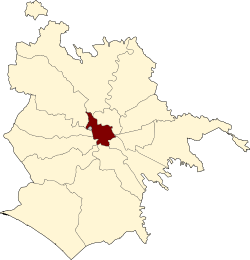14 regions of Augustan Rome
In 7 BC, Augustus divided the city of Rome into 14 administrative regions (Latin regiones, sing. regio). These replaced the four regiones — or "quarters" — traditionally attributed to Servius Tullius, sixth king of Rome. They were further divided into official neighborhoods (vici).[1]

Originally designated by number, the regions acquired nicknames from major landmarks or topographical features within them. After the reign of Constantine the Great, the imperial city of Constantinople was also divided into fourteen regiones, on the Roman example: the 14 regions of Constantinople.[2]
The 14 regions

I: Regio I Porta Capena
Regio I took its name from the Porta Capena ("Gate to Capua"), a gate of the Servian Walls, through which the Appian Way takes to get into the city. Beginning from this to the south of the Caelian Hill, it runs to the future track of the Aurelian Walls.
II: Regio II Caelimontium
Regio II encompassed the Caelian Hill.
III: Regio III Isis et Serapis
Regio III took its name from the sanctuary of Isis, in the area of the modern Labicana street, containing the valley that was to be the future site of the Colosseum, and parts of the Oppian and Esquiline hills.
IV: Regio IV Templum Pacis
Regio IV took its name from the Temple of Peace built in the region by Vespasian. It includes the valley between the Esquiline and the Viminal hills, the popular area of the Subura, and the Velian Hill (the hill between the Palatine and the Oppian Hill, removed in the early 20th century to make way for the via dei Fori Imperiali, the street passing between the Forum Romanum and the Forum of Augustus).
V: Regio V Esquiliae
The name of Regio V derives from the Esquiline hill. It contains parts of the Oppian and Cispian (two minor hills close to the city center) and of the Esquiline, plus the plain just outside the Servian walls.
VI: Regio VI Alta Semita
The name of Regio VI derives from the street (Alta Semita, "High Path") passing over the Quirinal Hill. It was a large regio that encompassed also the Viminal Hill, the lower slopes of the Pincian, and the valleys between these. Its major landmarks included the Baths of Diocletian, the Baths of Constantine, and the Gardens of Sallust; gardens (horti) covered much of its northern part. Temples to Quirinus, Salus, and Flora were also located in Regio VI, and the Castra Praetoria. The Aurelian Wall marked most of its eastern and northern edge, with the Argiletum and Vicus Patricius on the south and southeast.[3]
VII: Regio VII Via Lata
The name of Regio VII was derived from the via Flaminia, which runs between the Servian walls and the future Aurelian Walls. This was a wide urban street (Via Lata, "Broadway"), corresponding to the modern via del Corso. The regio contained part of the Campus Martius on the east of the street plus the Collis Hortulorum (Hill of the Hortuli), the Pincian Hill (modern Pincio).
VIII: Regio VIII Forum Romanum
The central region contains the Capitoline Hill, the valley between the Palatine and the Capitoline hills (where the Forum Romanum is located), and the area between Velian Hill and the Palatine up to the Arch of Titus and the Temple of Venus and Roma.
IX: Regio IX Circus Flaminius
The name derives from the racecourse located in the southern end of the Campus Martius, close to Tiber Island. The region contains part of the Campus Martius, on the west side of via Lata.
X: Regio X Palatium
The Palatine Hill gave its name to Regio X.[4]
XI: Regio XI Circus Maximus
Regio XI took its name from the Circus Maximus, located in the valley between the Palatine and the Aventine. It contained the Circus Maximus, the Velabrum (the valley between the Palatine and Capitoline), as well as the areas next to the Forum Boarium and the Forum Holitorium.
XII: Regio XII Piscina Publica
Regio XII took its name from the Piscina Publica, a monument that disappeared during the Empire. It had the high ground where the church of San Saba is at present, plus its ramifications towards the Appian Way, where Caracalla's baths were.
In the 180s, a bank and exchange for Christians operated in the area.[5]
XIII: Regio XIII Aventinus
Regio XIII contained the Aventine Hill and the plain in front of it, along the Tiber.[6] Here was the Emporium, the first port on the river.
XIV: Regio XIV Transtiberim
Regio XIV (the region "across the Tiber") contained Tiber Island and all the parts of Rome west beyond the Tiber.[7] This is modern Trastevere.
See also
Notes
- J. Bert Lott (19 April 2004). The Neighborhoods of Augustan Rome. Cambridge University Press. ISBN 978-0-521-82827-7.
- Matthews, John (2012). "The Notitia Urbis Constantinopolitanae". In Grig, Lucy; Kelly, Gavin (eds.). Two Romes: Rome and Constantinople in late Antiquity. Oxford: Oxford University Press. pp. 81–115. ISBN 978-0-19-973940-0. OCLC 796196995.
- Lawrence Richardson, A New Topographical Dictionary of Ancient Rome (Johns Hopkins University Press, 1992), p. 6.
- Malaise (1 December 1972). Inventaire préliminaire des documents égyptiens découverts en Italie. BRILL Publishers. p. 215. ISBN 9789004296244.
- Peter Lampe, Christians at Rome in the First Two Centuries (Continuum, 2003), p. 42 online.
- Mignone, Lisa (31 May 2016). The Republican Aventine and Rome’s Social Order. University of Michigan Press. p. 3. ISBN 9780472119882.
- Funghi, M.; Troiano, W. (2015). "Santa Maria dell'Orto. Il complesso architettonico trasteverino.". L'area meridionale della Regio XIV Transtiberim in età romana: storia degli scavi e cenni di inquadramento topografico. Roma: Studi. Progetti. Restauri. p. 3-14 – via Academia.edu.
References
- DISCRIPTIO XIIII REGIONVM VRBIS ROMÆ, Curiosum - Notitia. 4th-century descriptions of the regions of Rome and their main buildings. Archived from the original on 8 June 2019.